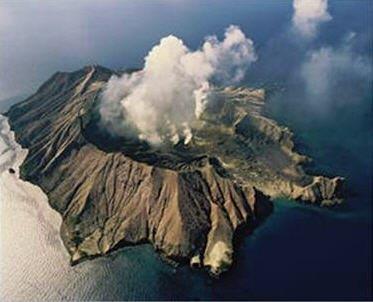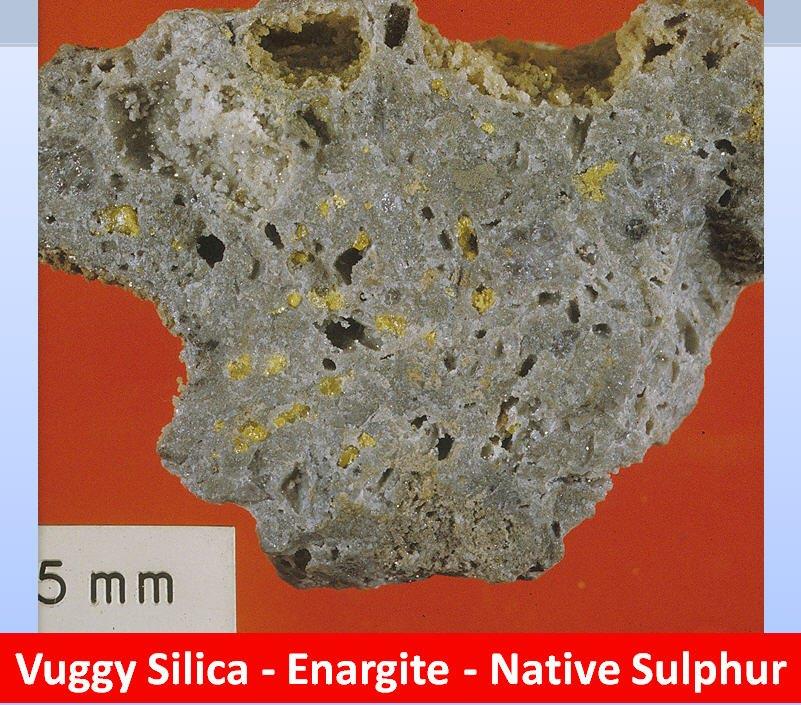You are using an out of date browser. It may not display this or other websites correctly.
You should upgrade or use an alternative browser.
You should upgrade or use an alternative browser.
unknown find from slatey
- Thread starter Fishing for gold
- Start date

Help Support Prospecting Australia:
This site may earn a commission from merchant affiliate
links, including eBay, Amazon, and others.
- Joined
- May 1, 2014
- Messages
- 1,958
- Reaction score
- 2,530
Firstly, because basically you are saying that I have said things that I have not said
Apologies if I did that Goldirocks - you have posted a great deal of information and it takes some time to sort through it, partly because of the volume and also partly because the various scientific and related disciplines tend to use their own specialized languages which makes it a bit more confusing again. I wasn't originally fully certain of the context I was supposed to take the term "spatial" in though I did figure you must have considered it important since you made the reference several times.
I'm sure you've noticed that the spatial argument I'm making is somewhat deeper than "the wood is near volcanics so that must be what did it". As previously mentioned, there's an array of factors that lead me to my conclusion, only one of which is that it happens to be there.
I'm very interested to see "cold-formed" agates/chalcedonies, I found a couple of references but I can't find anywhere showing actual examples. It would be interesting to compare them to the various things I've found only in igneous spots.
When I'm talking about chalcedony lying beside and intergrown with the Riverslea wood, this is the sort of stuff I mean. Mostly deeply pitted and bubbly globs, some sporting (or made up of) botryoidal growths. Often but not always hollow, translucent to sometimes near-transparent. Sometimes containing quartz crystals, sometimes a quantity of water and an air/gas bubble.
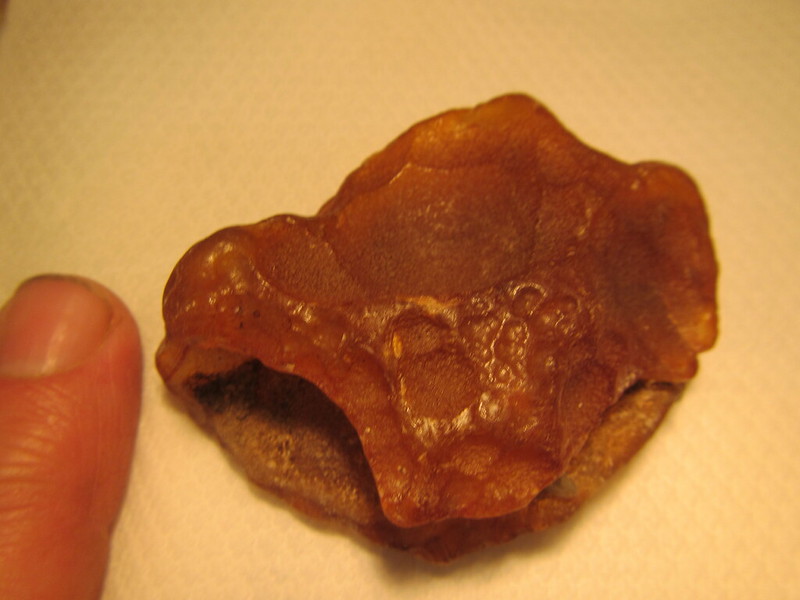
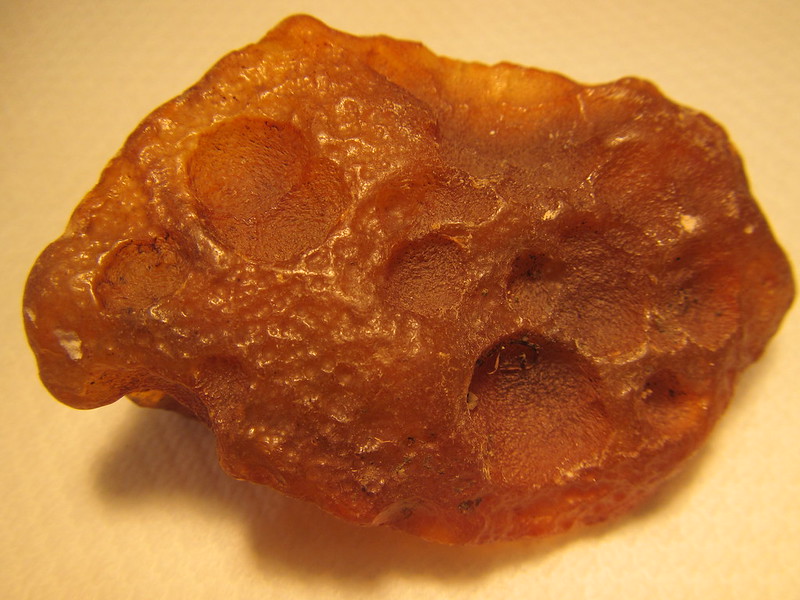
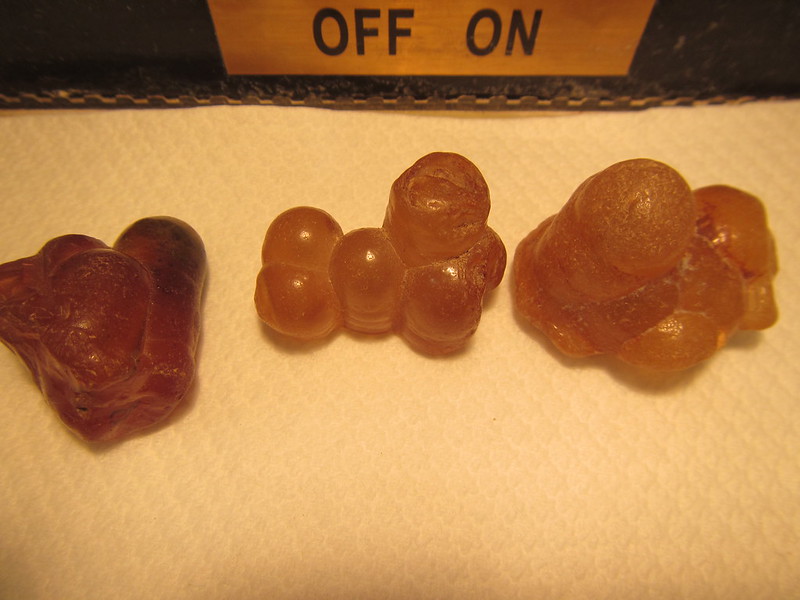
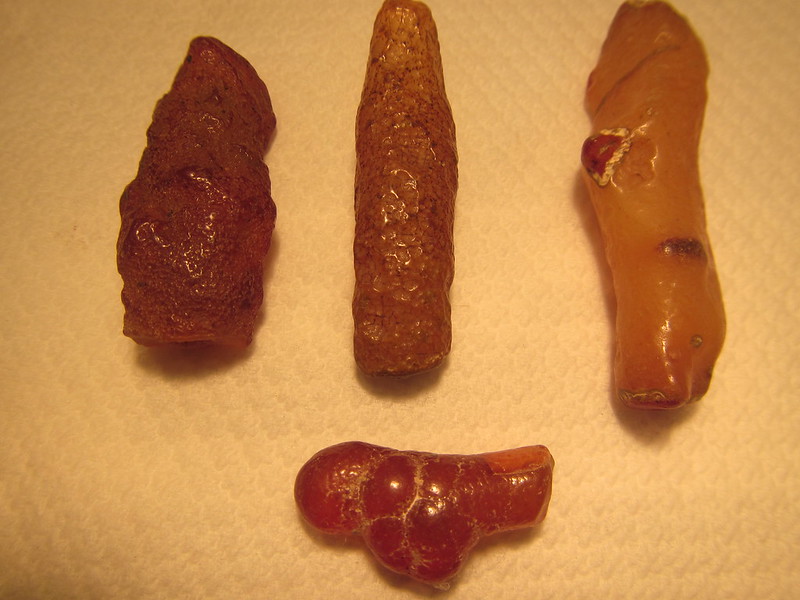
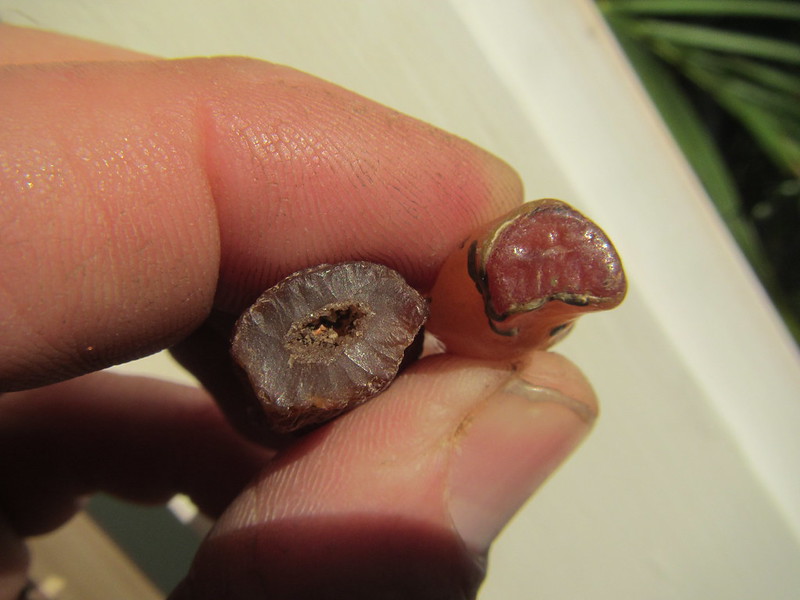
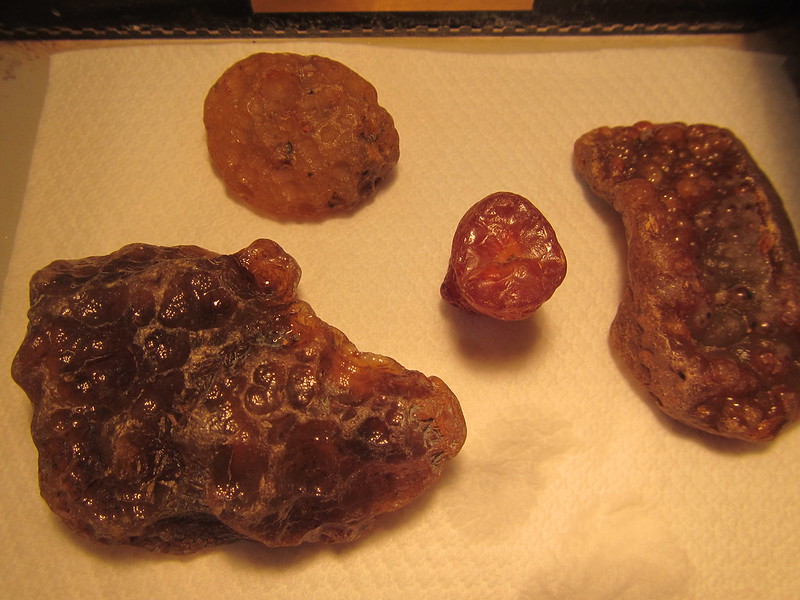
Another bit of wood with the chalcedony on it (possibly originally in it, the wood has grain running the same direction as the marks in the chalcedony on the other side.
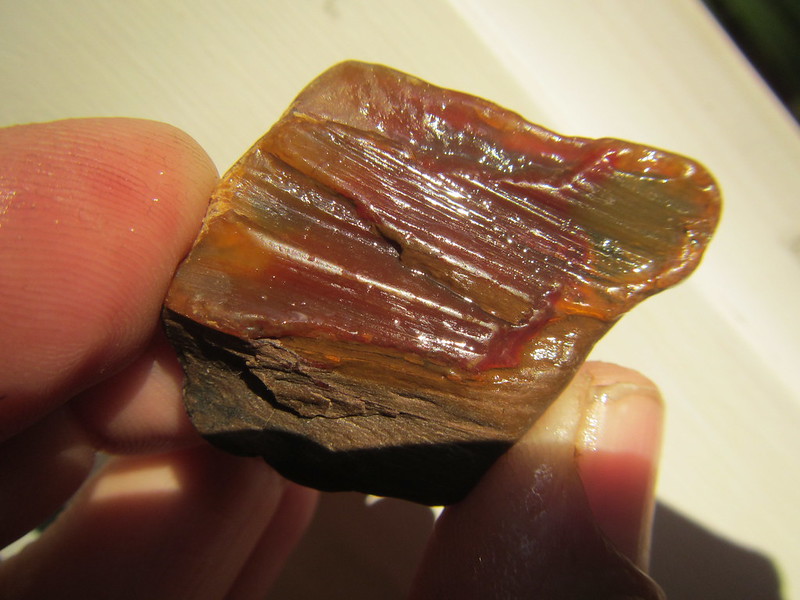
These bits are interesting. I had a number of them, not sure where the others are. I did cut up one of them to make a cab. The bottom of these pieces is dead flat. They resemble a cowpat, like a glob of something only semi-solid that fell and landed on a perfectly flat surface. Or started on a flat surface and grew up from it. Looks curved here but that's just the edge. They sit nicely on a shelf unaided.
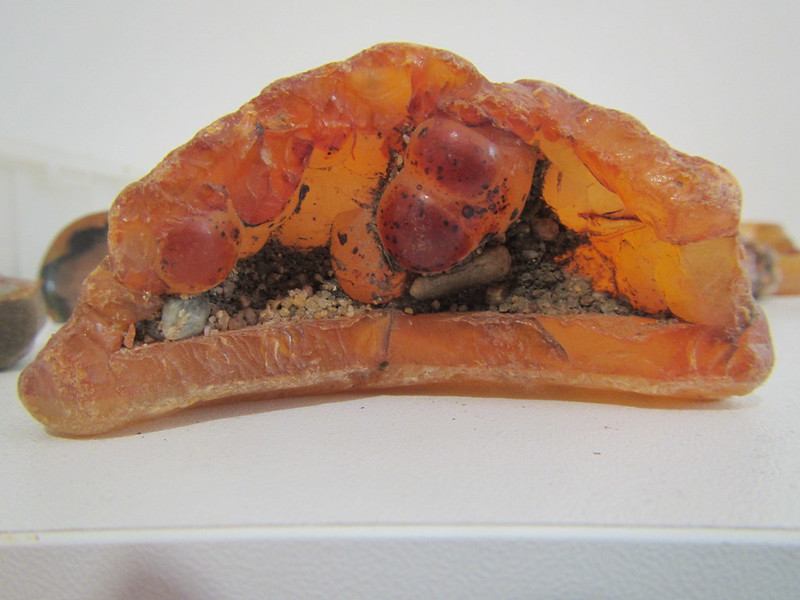
- Joined
- May 1, 2014
- Messages
- 1,958
- Reaction score
- 2,530
Still chugging through it all.
I'm sure you're just hypothesizing there - because otherwise it would be misrepresenting what I'm saying by simplifying it in the extreme and neglecting to mention a variety of other observations that go along with it You can accurately date petrified wood by looking at photographs?
You can accurately date petrified wood by looking at photographs?
Again, I'd like to grab myself some specimens of Agates apparently originating in non-igneous environments for my collection. In this neck of the woods, the spatial relationship between such materials and igneous rocks appears very strong. Every example I can think of comes directly out of or very close to something igneous. Conversely, it seems difficult to find examples within this region of them originating in non-igneous rocks, though I'm sure they exist.
When I can be shown significant numbers of examples of such stuff from sites widely distributed around my region, then I might have cause to review my thinking more. Literature notwithstanding, when the spatial relationship with igneous features in this area appears so strong and examples to the contrary are hard to come by - it does not make sense to put it all down to nothing more than a series of purely coincidental occurences, time and again and again.
I would say - "the petrified wood does not have an igneous origin, because it originated 26 My years after the basalt formed, from wood perhaps deposited 1 My earlier than the petrification - at a time after the lava coolled completely and started to be weathered". Lefty might say "it is in tuff which is a volcanic rock which is igneous so the bloody thing has an igneous origin". I would say, no, it didn't originate then, it originated 25 My later (its genesis was 25 My later), so we cannot possibly say its origin (genesis) is igneous - the two things (tuff and petrified wood) originated at vastly different times. Do you see why I say we are going around in circles?
I'm sure you're just hypothesizing there - because otherwise it would be misrepresenting what I'm saying by simplifying it in the extreme and neglecting to mention a variety of other observations that go along with it
Again, I'd like to grab myself some specimens of Agates apparently originating in non-igneous environments for my collection. In this neck of the woods, the spatial relationship between such materials and igneous rocks appears very strong. Every example I can think of comes directly out of or very close to something igneous. Conversely, it seems difficult to find examples within this region of them originating in non-igneous rocks, though I'm sure they exist.
When I can be shown significant numbers of examples of such stuff from sites widely distributed around my region, then I might have cause to review my thinking more. Literature notwithstanding, when the spatial relationship with igneous features in this area appears so strong and examples to the contrary are hard to come by - it does not make sense to put it all down to nothing more than a series of purely coincidental occurences, time and again and again.
silver
silver
- Joined
- Dec 19, 2013
- Messages
- 18,889
- Reaction score
- 25,813
I'd like to understand how timber can still be timber in the ground for One My still holding its grain perfectly for so long and then still undergo petrification processes all that time later ,... I find it much easier to conceive that during the volcanic upheaval (as cataclysmic as it was) the surrounding humus and macro environment for some extent undergoing extraordinary circumstances being put through the immediate (in geological terms) transformational batch of geochemical soup required to give the on the ground verification of Just That Process that is being seen and found by the man on the ground, is what we are seeing (whew ,.... big sentence right there). 
Some beautiful pieces Lefty, some of the bits in the fourth photo look like stalactites.
This is why most of the wood preserved is from trees and wood that wend down in water or stumps that were close by the water, because you get a lot of rapid deposition associated which aids in the initial preservation. I am sure most of us have seen how devastating a good flood can be, imagine all the trees, bits of wood and stumps that can get buried during these events. Heck even think of drift wood.
With rapid deposition, whether from floods, basin, swamp, volcanic ash or lava, the wood does not have time to decay like it normally would.
But i think what goldierocks is getting at, is that even if a forest was buried in volcanic ash, this does not ensure the wood will be petrified as it still needs silica rich waters flowing through the ground to start the silica replacing the wood. This i believe is not something that happens over night, but is an extremely lengthy process.
In saying that i believe there are cases where the lava flow itself has preserved wood, such as the basalt flow at Crinum, Central Queensland. Where fossilized wood is pulled directly out of the basalt.
Lefty a quick question, the wood in your area you find, i assume you mainly grab it out of the creeks/rivers but do you know what rock it is coming out of or has shed from?
I'd like to understand how timber can still be timber in the ground for One My still holding its grain perfectly for so long and then still undergo petrification processes all that time later
This is why most of the wood preserved is from trees and wood that wend down in water or stumps that were close by the water, because you get a lot of rapid deposition associated which aids in the initial preservation. I am sure most of us have seen how devastating a good flood can be, imagine all the trees, bits of wood and stumps that can get buried during these events. Heck even think of drift wood.
With rapid deposition, whether from floods, basin, swamp, volcanic ash or lava, the wood does not have time to decay like it normally would.
But i think what goldierocks is getting at, is that even if a forest was buried in volcanic ash, this does not ensure the wood will be petrified as it still needs silica rich waters flowing through the ground to start the silica replacing the wood. This i believe is not something that happens over night, but is an extremely lengthy process.
In saying that i believe there are cases where the lava flow itself has preserved wood, such as the basalt flow at Crinum, Central Queensland. Where fossilized wood is pulled directly out of the basalt.
Lefty a quick question, the wood in your area you find, i assume you mainly grab it out of the creeks/rivers but do you know what rock it is coming out of or has shed from?
- Joined
- May 1, 2014
- Messages
- 1,958
- Reaction score
- 2,530
silver said:I'd like to understand how timber can still be timber in the ground for One My still holding its grain perfectly for so long and then still undergo petrification processes all that time later ,... I find it much easier to conceive that during the volcanic upheaval (as cataclysmic as it was) the surrounding humus and macro environment for some extent undergoing extraordinary circumstances being put through the immediate (in geological terms) transformational batch of geochemical soup required to give the on the ground verification of Just That Process that is being seen and found by the man on the ground, is what we are seeing (whew ,.... big sentence right there).
Yes, probably formed by an environment closely related to the volcanics (I think
Some beautiful pieces Lefty, some of the bits in the fourth photo look like stalactites.
Cheers Shivan. Yes, some of the chalcedony pieces have quite an unusual apearence. Not sure about the 2 stalactite pieces to the left but the one on the right resembles a piece of tree root - perhaps a root had already died, rooted out and left a cast of itself in the soil, which was then filled by silica. Or perhaps not. Interesting in any case.
In saying that i believe there are cases where the lava flow itself has preserved wood, such as the basalt flow at Crinum, Central Queensland. Where fossilized wood is pulled directly out of the basalt.
That's interesting, I don't think I've actually heard of that place.
Lefty a quick question, the wood in your area you find, i assume you mainly grab it out of the creeks/rivers but do you know what rock it is coming out of or has shed from?
Sorry, no I don't. The general area is dotted with volcanic plugs and the river seems to have cut through a field of these interesting materials. It appears to be just shedding from out of the banks along a certain stretch. I've seen granite and basalt in other places where I've found some similar-ish types of materials and Mount Hay a short distance away is apparently extruded rhyolitic lava but I haven't been able to identify any kind of mother rock for it all. A short-ish distance in the other direction, some bloke apparently felt he had cause to prospect for diamonds - haven't heard if any were ever found.
Cheers
silver said:I'd like to understand how timber can still be timber in the ground for One My still holding its grain perfectly for so long and then still undergo petrification processes all that time later ,... I find it much easier to conceive that during the volcanic upheaval (as cataclysmic as it was) the surrounding humus and macro environment for some extent undergoing extraordinary circumstances being put through the immediate (in geological terms) transformational batch of geochemical soup required to give the on the ground verification of Just That Process that is being seen and found by the man on the ground, is what we are seeing (whew ,.... big sentence right there).
Fair comment - it can survive under oxygen-poor conditions (eg Permian coal seams), and as I mentioned they used to carve walking sticks from wood in the Ballarat gold deep leads (I want one for my old age). However sometimes things appear to go through an intermediate stage to be immediately replaced by something else (eg a carbonate), which is then replaced in turn again much later, Not saying this is necessarily the case in this instance. I am always intrigued by the survival of things like dinosaur skin and feathers etc.
Just been doing a bit more reading and found an interesting article i had read a while ago that may interest you Lefty on the formation of agate.
http://news.psu.edu/story/140648/2001/09/01/research/how-do-agates-form
I found it interesting the two different theories on how the agate precipitated, but it is commonly accepted that agate forms at low pressure and temp:
I still am trying to understand how the silica can get dissolved in cooler waters, i understand we are not talking quartz, but silica. But again i was still under the impression the waters needed to be heated to allow the the silica to dissolve into water and allow super saturation of silica in the water, unless acidification of the silica had been present.
I am finding it hard to find any new information on this as most publications seem from the 50's such as:
http://ngds.egi.utah.edu/files/GL03781/GL03781.pdf
There seems to be something about the process i am not understanding or misinterpreting. Will go back over it all a bit later.
http://news.psu.edu/story/140648/2001/09/01/research/how-do-agates-form
I found it interesting the two different theories on how the agate precipitated, but it is commonly accepted that agate forms at low pressure and temp:
"I think that the silicate that precipitates onto the walls has to be a little bit polymerized. Not long strings of molecules, as in a protein, but repeat units of five to ten molecules. If the concentration of silica in water gets high enough, the silica polymerizes. This is how it happens;" He crosses to the blackboard and writes:
formula for oxygen and silicon atoms
"The oxygen serves as a bridge between two silicon atoms.
"These polymers get pulled out of the solution and get incorporated into the crystal very quickly. When things are polymerized, they'll crystallize very rapidly. You've overcome some of the initiation energy needed to make the crystal. And because the crystallization occurs so quickly, mistakes are made and weird minerals like moganite are formed.
"Soon, though, the polymers get depleted from the solution, leaving isolated Si(OH)4 units. You can crystallize perfect quartz crystals without moganite from these, but it's very slow. At room temperature, you can let the solution sit for two years before you'll see the beginning of the crystallization process."
Between the crystal fibers are channels that work by capillary action to pull water into the center of the hole in the rock. "If you have a continuous supply of water feeding silica to the system," Heaney says, "then when the concentration gets higher, the silica will begin to polymerize again and it will begin to crystallize rapidly again. That's why I think an agate has its banding pattern.
"This has not been experimentally shown," Heaney says. "You'd have to make an agate, and no one has ever made an agate, though Robert thinks we should try." Heaney and a Russian mathematician, an expert in fractal geometry, are submitting a grant proposal to simulate this oscillating pattern of crystal growth on a computer.
"There is a competing theory that I don't like at all," Heaney adds, "and it's one that Robert favors. You have a gel, a silica jello embedded in the rock, and by adding chemicals you produce periodic bands in it. You can make a silica gel in the lab very easily. You can even get the banding. But when you let the gel dry, it dries to an amorphous or non-crystalline form of silica." While high temperatures or pressures might cause the gel to crystallize, those forces do not come into play. "We know agates form close to the surface of the earth, at low pressures and temperatures," Heaney says, "and not only in volcanic rock, but in dinosaur bones."
We also know agates invariably outlast their surroundings. The encasing rockor boneweathers away, leaving just a roundish, rough-coated lump waiting to be picked up and cut and polished.
I still am trying to understand how the silica can get dissolved in cooler waters, i understand we are not talking quartz, but silica. But again i was still under the impression the waters needed to be heated to allow the the silica to dissolve into water and allow super saturation of silica in the water, unless acidification of the silica had been present.
I am finding it hard to find any new information on this as most publications seem from the 50's such as:
http://ngds.egi.utah.edu/files/GL03781/GL03781.pdf
There seems to be something about the process i am not understanding or misinterpreting. Will go back over it all a bit later.
Lefty said:Still chugging through it all.
I would say - "the petrified wood does not have an igneous origin, because it originated 26 My years after the basalt formed, from wood perhaps deposited 1 My earlier than the petrification - at a time after the lava coolled completely and started to be weathered". Lefty might say "it is in tuff which is a volcanic rock which is igneous so the bloody thing has an igneous origin". I would say, no, it didn't originate then, it originated 25 My later (its genesis was 25 My later), so we cannot possibly say its origin (genesis) is igneous - the two things (tuff and petrified wood) originated at vastly different times. Do you see why I say we are going around in circles?
I'm sure you're just hypothesizing there - because otherwise it would be misrepresenting what I'm saying by simplifying it in the extreme and neglecting to mention a variety of other observations that go along with itYou can accurately date petrified wood by looking at photographs?
Again, I'd like to grab myself some specimens of Agates apparently originating in non-igneous environments for my collection. In this neck of the woods, the spatial relationship between such materials and igneous rocks appears very strong. Every example I can think of comes directly out of or very close to something igneous. Conversely, it seems difficult to find examples within this region of them originating in non-igneous rocks, though I'm sure they exist.
When I can be shown significant numbers of examples of such stuff from sites widely distributed around my region, then I might have cause to review my thinking more. Literature notwithstanding, when the spatial relationship with igneous features in this area appears so strong and examples to the contrary are hard to come by - it does not make sense to put it all down to nothing more than a series of purely coincidental occurences, time and again and again.
I was giving a hypothetical process to explain what I was trying to describe - those are just imaginary ages pulled out of thin air. Sorry if that was not clear. In fact I think it would be much more common overall for the time delay to be relatively short - more like hundreds of thousands of years than tens of millions). You've gone back to agates again, I'm not sure that you need to review your ideas on that at all. The comment re spatial was that you seem to say that because something occurs in an igneous rock, it therefore is genetically related to it (because they occur together). I was pointing out that the two conclusions do not necessarily follow one from the other. For example, a vesicular volcanic rock can have cold groundwater flow through it millions of years later, dissolve silica and re-deposit it as agate in the vesicles. However in the case of agate I have seen many examples that I would happily ascribe to silica being deposited in vesicles when the rock was still hot, from hot water that derived its silica from the rock (but not NECESSARILY water that came out of the magma). That is what I meant about jumping around a bit from mineral to mineral - pet wood and Australian precious opals are the ones that I consider to least often (but not never) related to hot water or igneous activity, agate often is. Foreign precious opal and the opal right where you were discussing in New England are examples where the opal probably does form in the volcanics from hot water. Hence my comment about disagreeing less than you seem to think.
One problem I have is that you are often not making it clear to me where you see these minerals (eg fossil wood) - eg embedded in basalt or tuff, in old gravels derived from them, in a modern stream in their vicintiy. That makes it difficult to interpret what exactly you are using as evidence for a relationship. I read of examples in your area where the pet wood is embedded in tuff, but sadly I have only ever visited your area, not spent time looking in detail there, so I can only guess and offer what I consider equally plausible explanations based on what I know well in other areas.
shivan said:Some beautiful pieces Lefty, some of the bits in the fourth photo look like stalactites.
I'd like to understand how timber can still be timber in the ground for One My still holding its grain perfectly for so long and then still undergo petrification processes all that time later
This is why most of the wood preserved is from trees and wood that wend down in water or stumps that were close by the water, because you get a lot of rapid deposition associated which aids in the initial preservation. I am sure most of us have seen how devastating a good flood can be, imagine all the trees, bits of wood and stumps that can get buried during these events. Heck even think of drift wood.
With rapid deposition, whether from floods, basin, swamp, volcanic ash or lava, the wood does not have time to decay like it normally would.
But i think what goldierocks is getting at, is that even if a forest was buried in volcanic ash, this does not ensure the wood will be petrified as it still needs silica rich waters flowing through the ground to start the silica replacing the wood. This i believe is not something that happens over night, but is an extremely lengthy process.
In saying that i believe there are cases where the lava flow itself has preserved wood, such as the basalt flow at Crinum, Central Queensland. Where fossilized wood is pulled directly out of the basalt.
Lefty a quick question, the wood in your area you find, i assume you mainly grab it out of the creeks/rivers but do you know what rock it is coming out of or has shed from?
Yes, although overall with pet wood I would think it most cases it is not tens of millions of years, as I note above. However later replacement processes are common. Australian precious opal is mostly mid-Tertiary but it replaces things like Jurassic dinosaur bones, ikaiite crystals, brachiopods and belemnites. That is a very long time interval between the fossil being deposited and the silica replacement occurring (more than 150 My).
Agree re Crinum. I have another post where I walked a lava flow only weeks old in Hawaii and it was a graveyard of preserved tree stumps (I photographed them but unfortunately can't locate photos). Not so surprising - a fairly fluid lava flow in a tropical downpoor will trap things, solidify but prevent burning of wood. In things like coal seams I suspect that the oxygen-poor (anaerobic) conditions prevent oxidation of wood and suppress the bacteria and other organisms that would normally destroy it rapidly (just hypothesizing)
Not my photos:
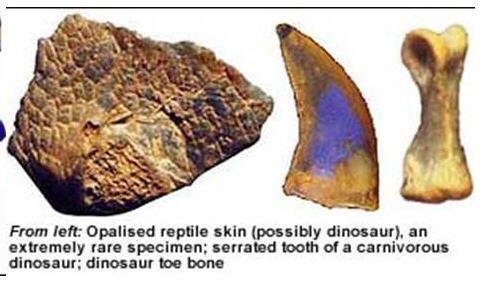
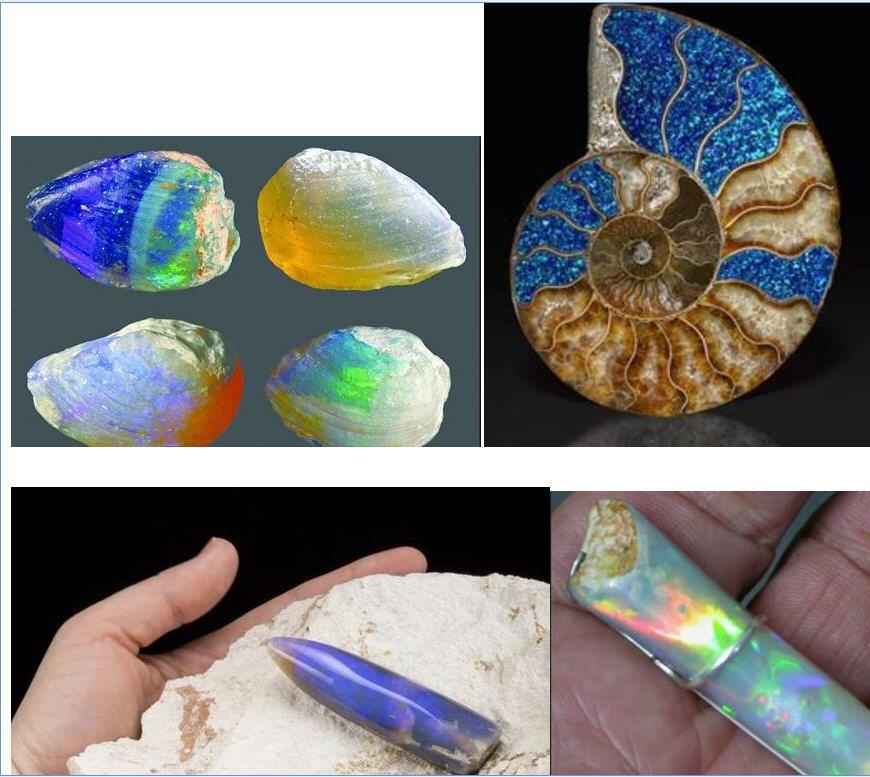
shivan said:Some beautiful pieces Lefty, some of the bits in the fourth photo look like stalactites.
I'd like to understand how timber can still be timber in the ground for One My still holding its grain perfectly for so long and then still undergo petrification processes all that time later
This is why most of the wood preserved is from trees and wood that wend down in water or stumps that were close by the water, because you get a lot of rapid deposition associated which aids in the initial preservation. I am sure most of us have seen how devastating a good flood can be, imagine all the trees, bits of wood and stumps that can get buried during these events. Heck even think of drift wood.
With rapid deposition, whether from floods, basin, swamp, volcanic ash or lava, the wood does not have time to decay like it normally would.
But i think what goldierocks is getting at, is that even if a forest was buried in volcanic ash, this does not ensure the wood will be petrified as it still needs silica rich waters flowing through the ground to start the silica replacing the wood. This i believe is not something that happens over night, but is an extremely lengthy process.
In saying that i believe there are cases where the lava flow itself has preserved wood, such as the basalt flow at Crinum, Central Queensland. Where fossilized wood is pulled directly out of the basalt.
Lefty a quick question, the wood in your area you find, i assume you mainly grab it out of the creeks/rivers but do you know what rock it is coming out of or has shed from?
Photos look texturally identical to what we see around Melbourne - some of those look like replaced root casts to me (guessing)
I still am trying to understand how the silica can get dissolved in cooler waters, i understand we are not talking quartz, but silica. But again i was still under the impression the waters needed to be heated to allow the the silica to dissolve into water and allow super saturation of silica in the water, unless acidification of the silica had been present.
I am finding it hard to find any new information on this as most publications seem from the 50's such as:
There seems to be something about the process i am not understanding or misinterpreting. Will go back over it all a bit later.
If silica could not dissolve in cold water we would have very little high quality agricultural land, virtually no soil at all, and we would not see weathered rocks. These things form from the underlying rocks and in most cases are less silica -rich by far than the rocks they are derived from (an exception is where the underlying rock is quartz-rich, like granite, because quartz is quite difficult to dissolve at low temperature, so the soils above granite can be more quartz-rich than the granite beneath, because only its mica and feldspar break down and the quartz concentrates above it as quartz sand). A classic example is basalt that I mentioned - you can see easily that the feldspar and olivine in the basalt have weathered to things like magnesite, serpentine and clays, which all are lower in silica content than the basalt meneath them. In the extreme case, the basalt becomes so leached of its silica that it becomes bauxite - the basalt alters first to things like clays (which contain Al and some Si), but under high rainfall tropical conditions even the clays break down to hydrous Al oxides (gibsite, diaspore) which become our aluminium ores. Half the nickel ores of the world form in the same way, by weathering of peridotite to serpentine that then breaks down further and the silica and nickel released are re-precipitated as the nickel silicate garnieirite. With lesser weather the nickel will simply coliour some of the silica released and precipitated as chalcedony to form what collectors form chrysoprase). These are not new ideas, they have been accepted for at least a century.
The principle is this. Minerals crystallise in a certain range of temperature, pressure and compositional conditions (aqueous fluid, magma) conditions. They can survive under cooler or lower pressure conditions metastably for some time if brought to surface (or after a lava cools at surface). But ultimately they are still unstable minerals under those conditions, and will gradually or rapidly change into other minerals that are stable under the changed conditions. Things like olivine and plagioclase are stable under higher P-T conditions but will break down to serpentine and clays which are the minerals stable under low T-P conditions. With some minerals (eg olivine), cold rainwater is enough to trigger this and rapidly convert it to other minerals. Felspars are a bit slower (stream sand usually still has some unaltered felspar in it as well as quartz, so the rock it is derived from is breaking down more rapidly mechanically than chemically, but a proportion of feldspar will nevertheless have broken down chemically back in the weathered rock it is derived from. With other minerals it is slower unless you have hot water (e.g to dissolve quartz itself) - nevertheless even quartz will dissolve extremely slowly at surface in cold water given sufficient time, but it requires really major geological time (it can persist for tens of millions of years, and the rock will normally be physically broken down into sand that is carried away in streams before that occurs). The rate that minerals break down will vary a lot depending on topography and rainfall - I have seen fresh pyrite in stream sands in active mountain areas, but even quartz will break down chemically in a flat, warm, swampy plain (but you won't see pyrite in streams flowing over the plain, just Fe oxides formed from the pyrite - sometimes you will only see pyrite appearing at depths of hundreds of metres in mines, and all above is altered to limonite - I have seen this extend to depths of one km in places - when I was mine geologist on the Tsumeb mine).
Don't worry, geology is a complex and highly physical, chemical and descriptive science and takes time to fully grasp (I've had nearly 50 years to do that) - however as each concept is grasped, one usually has a Eureka! moment, where a lot of things that were previously not understood all become clear very rapidly. Recognising that silica is released when all sorts of rocks weather at low temperature is such a case - think of all the gemstones I have mentioned that form in this way for starters!
I am finding it hard to find any new information on this as most publications seem from the 50's such as:
There seems to be something about the process i am not understanding or misinterpreting. Will go back over it all a bit later.
If silica could not dissolve in cold water we would have very little high quality agricultural land, virtually no soil at all, and we would not see weathered rocks. These things form from the underlying rocks and in most cases are less silica -rich by far than the rocks they are derived from (an exception is where the underlying rock is quartz-rich, like granite, because quartz is quite difficult to dissolve at low temperature, so the soils above granite can be more quartz-rich than the granite beneath, because only its mica and feldspar break down and the quartz concentrates above it as quartz sand). A classic example is basalt that I mentioned - you can see easily that the feldspar and olivine in the basalt have weathered to things like magnesite, serpentine and clays, which all are lower in silica content than the basalt meneath them. In the extreme case, the basalt becomes so leached of its silica that it becomes bauxite - the basalt alters first to things like clays (which contain Al and some Si), but under high rainfall tropical conditions even the clays break down to hydrous Al oxides (gibsite, diaspore) which become our aluminium ores. Half the nickel ores of the world form in the same way, by weathering of peridotite to serpentine that then breaks down further and the silica and nickel released are re-precipitated as the nickel silicate garnieirite. With lesser weather the nickel will simply coliour some of the silica released and precipitated as chalcedony to form what collectors form chrysoprase). These are not new ideas, they have been accepted for at least a century.
The principle is this. Minerals crystallise in a certain range of temperature, pressure and compositional conditions (aqueous fluid, magma) conditions. They can survive under cooler or lower pressure conditions metastably for some time if brought to surface (or after a lava cools at surface). But ultimately they are still unstable minerals under those conditions, and will gradually or rapidly change into other minerals that are stable under the changed conditions. Things like olivine and plagioclase are stable under higher P-T conditions but will break down to serpentine and clays which are the minerals stable under low T-P conditions. With some minerals (eg olivine), cold rainwater is enough to trigger this and rapidly convert it to other minerals. Felspars are a bit slower (stream sand usually still has some unaltered felspar in it as well as quartz, so the rock it is derived from is breaking down more rapidly mechanically than chemically, but a proportion of feldspar will nevertheless have broken down chemically back in the weathered rock it is derived from. With other minerals it is slower unless you have hot water (e.g to dissolve quartz itself) - nevertheless even quartz will dissolve extremely slowly at surface in cold water given sufficient time, but it requires really major geological time (it can persist for tens of millions of years, and the rock will normally be physically broken down into sand that is carried away in streams before that occurs). The rate that minerals break down will vary a lot depending on topography and rainfall - I have seen fresh pyrite in stream sands in active mountain areas, but even quartz will break down chemically in a flat, warm, swampy plain (but you won't see pyrite in streams flowing over the plain, just Fe oxides formed from the pyrite - sometimes you will only see pyrite appearing at depths of hundreds of metres in mines, and all above is altered to limonite - I have seen this extend to depths of one km in places - when I was mine geologist on the Tsumeb mine).
Don't worry, geology is a complex and highly physical, chemical and descriptive science and takes time to fully grasp (I've had nearly 50 years to do that) - however as each concept is grasped, one usually has a Eureka! moment, where a lot of things that were previously not understood all become clear very rapidly. Recognising that silica is released when all sorts of rocks weather at low temperature is such a case - think of all the gemstones I have mentioned that form in this way for starters!
Just throwing this out as a guess, but would it have anything to do with the decomposition of silanes, or them being able to break down and bond at a range of temps ( I could be way off )
This fossil jawbone, which has been quite extensively studied was found to still have the tiniest capilleries intact after becoming opalised, pretty amazing that such small and delicate features can remain intact through such geological processes and though such extremely long time periods.
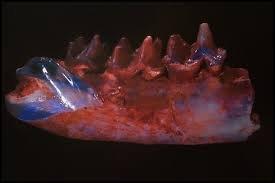
The fossil was found by Alan Galman and his brother Dave. Alan's son Shaun is a member here and are both good friends of mine.

The fossil was found by Alan Galman and his brother Dave. Alan's son Shaun is a member here and are both good friends of mine.
Because the weathering is so intense to form bauxite, it is hard to find an example which shows photographs of both the bauxite (which is fairly pure aluminium oxide without silica) and the silica-bearing rock rock it formed from - the bauxite often looks like this:
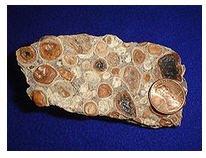
However I found one photo - the outer part of this specimen is pure bauxite (aluminium, all the silica has gone). The inner core is weathered basalt in which there is still lots of silica (as well as aluminium). You can see the shape of original felspar (plagioclase) laths in both the core, and preserved as shapes within the bauxite
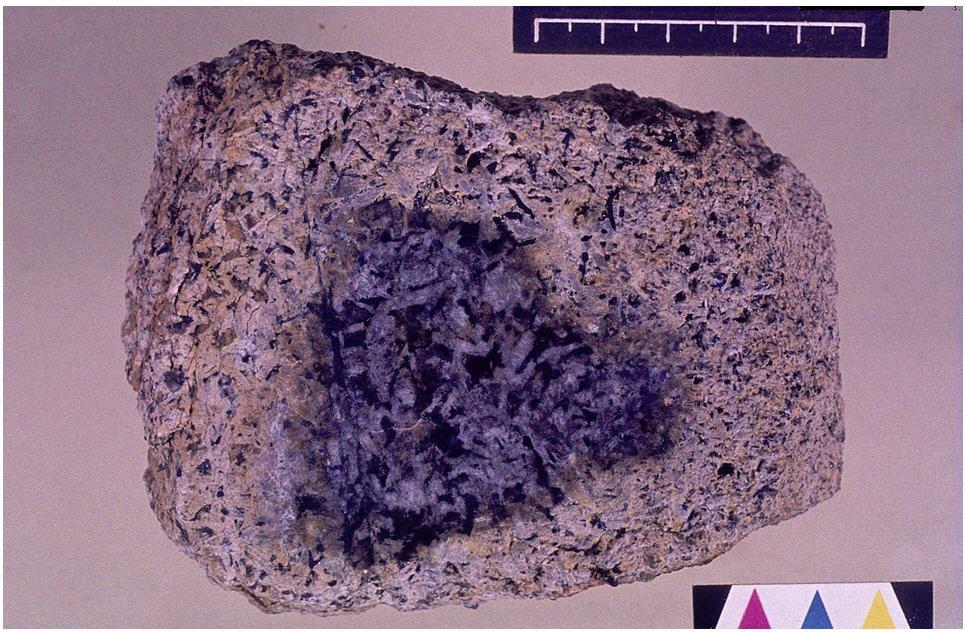
This is the fresh, unweathered basalt in which you can see the feldspars - it contains about 48% silica at this stage
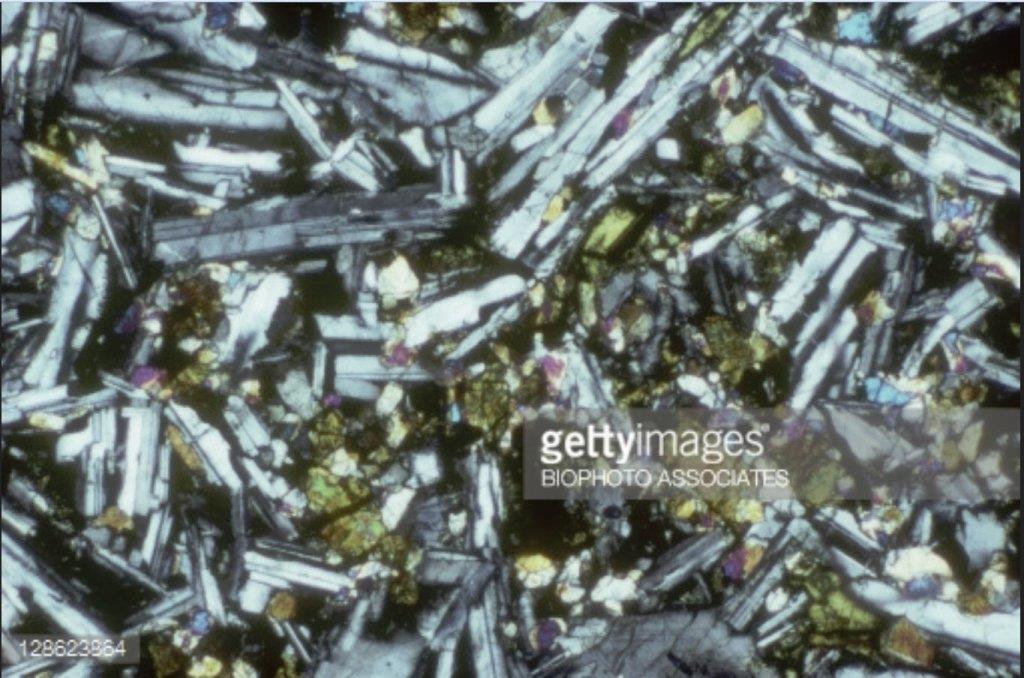

However I found one photo - the outer part of this specimen is pure bauxite (aluminium, all the silica has gone). The inner core is weathered basalt in which there is still lots of silica (as well as aluminium). You can see the shape of original felspar (plagioclase) laths in both the core, and preserved as shapes within the bauxite

This is the fresh, unweathered basalt in which you can see the feldspars - it contains about 48% silica at this stage

Cheers goldierocks.
Again i guess this is where i walk the thin line of what i do know and what i think i know
Some of what you describe i do understand i.e like the breaking down of less stable minerals to form more stable minerals depending on what is available in the mix and what was wanting to react and the P-T ratio. Though again my understanding is only very basic and probably where i have been falling down during this discussion.
I will keep processing all this info and go back over some of my notes to see if i can come to term with it all a bit more.
Again i guess this is where i walk the thin line of what i do know and what i think i know
Some of what you describe i do understand i.e like the breaking down of less stable minerals to form more stable minerals depending on what is available in the mix and what was wanting to react and the P-T ratio. Though again my understanding is only very basic and probably where i have been falling down during this discussion.
I will keep processing all this info and go back over some of my notes to see if i can come to term with it all a bit more.
- Joined
- May 1, 2014
- Messages
- 1,958
- Reaction score
- 2,530
Cheers Goldirocks.
I've been quite happy to accept all along the argument that something being found in close proximity to something else does not necessarily imply a causal relationship. Indeed, I would think this would often turn out to be the case. I just wasn't sure that you were taking in the fact that what I was saying ran slightly deeper than just "there's some extinct volcanoes, there's some petrified wood nearby - one must be responsible for the other. I've noted a number of factors that lead me to suspect a relationship and as you concur, "not necessarily" or "often not the case" does not automatically equal "never".
As I said, I'm at a bit of a disadvantage when it comes to being familiar with the most basic features of non-igneous geology because of I where I have always lived, where as you travel around you will always come across volcanic plugs and granite mountain ranges.
The fossil wood, the chalcedonies and other materials occur in abundance among the gravel banks of a river in the close vicinity of a volcanic area, the wood being the major constituent of the "interesting looking rocks". The river gravels themselves appear quite different to those I have seen elsewhere in that these materials are not only present, they are present in such abundance that they appear to make up some significant portion of the total gravel load of the river bed. Go some distance upstream of the site and they go from abundant to non-existent. I don't recall having seen any particular rock which may have played host but there may be pieces of it there among the gravels and I will be looking out for it next time.
They also look (to my eyes at least) to be superficially texturally similar to the volcanic chalcedony image you posted. They also look very similar to material I gained in a rock swap with a bloke over in Montana who tells me he collected them from the Yellowstone volcanic region somewhere - so similar it is difficult to tell some bits apart. I assume he collected them outside the national park and I am not in possession of illegally-fossicked material
I've been quite happy to accept all along the argument that something being found in close proximity to something else does not necessarily imply a causal relationship. Indeed, I would think this would often turn out to be the case. I just wasn't sure that you were taking in the fact that what I was saying ran slightly deeper than just "there's some extinct volcanoes, there's some petrified wood nearby - one must be responsible for the other. I've noted a number of factors that lead me to suspect a relationship and as you concur, "not necessarily" or "often not the case" does not automatically equal "never".
As I said, I'm at a bit of a disadvantage when it comes to being familiar with the most basic features of non-igneous geology because of I where I have always lived, where as you travel around you will always come across volcanic plugs and granite mountain ranges.
The fossil wood, the chalcedonies and other materials occur in abundance among the gravel banks of a river in the close vicinity of a volcanic area, the wood being the major constituent of the "interesting looking rocks". The river gravels themselves appear quite different to those I have seen elsewhere in that these materials are not only present, they are present in such abundance that they appear to make up some significant portion of the total gravel load of the river bed. Go some distance upstream of the site and they go from abundant to non-existent. I don't recall having seen any particular rock which may have played host but there may be pieces of it there among the gravels and I will be looking out for it next time.
Photos look texturally identical to what we see around Melbourne - some of those look like replaced root casts to me (guessing)
They also look (to my eyes at least) to be superficially texturally similar to the volcanic chalcedony image you posted. They also look very similar to material I gained in a rock swap with a bloke over in Montana who tells me he collected them from the Yellowstone volcanic region somewhere - so similar it is difficult to tell some bits apart. I assume he collected them outside the national park and I am not in possession of illegally-fossicked material
AtomRat said:Just throwing this out as a guess, but would it have anything to do with the decomposition of silanes, or them being able to break down and bond at a range of temps ( I could be way off )
Good question. At a local level Si can cycle in all sorts of forms (from your background you would be aware of organic cycling, it is in grasses, radiolaria, sponge spicules etc). Shallow sea water is commonly very low in silica for this reason, because of consumption by organisms. Most silica transport in water is commonly ascribed to undissociated monosilic acid as the monomer H4SiO4 or dimer H6Si2O7, but I doubt it is that simple, and colloidal rather than dissolved silica is important. A lot of silica doesn't move far - eg it rapidly precipitates as chalcedony to form silcrete etc (I used to know when I was walking over non-outcropping serpentinites in the arid WA deserts because of scattered chalcedony nodules everywhere derived from weathering of the serpentinites at depth and re-precipitation near surface through upward transport from the water table and evaporation). In fact, I would geologically map using that alone (I also use plants - some are confined to areas overlying limestone sufficient for me to map 10 m thick limestone layers for 10s of km without ever seeing them - I have used tree sensitivity to things like Ni, Mg and Cr to map serpentinites - I can pick this on aerial photgraphs as with the limestone plant). Some plants concentrate over high zinc and copper rocks, but it gets more complex as it depends on whether a plant is still colonosing an area or not - but we have used this to find orebodies (geobotany). I have played around more with biogeochemistry, e.g analysing Au and As in plant leaves and bark (all these things have complications, like the concentration of minor dust in leaves during growth, the dust often being far higher in the elements than the amount the organism can take up. However since we mostly use it in exploration in areas where ore bodies are far below surface it can work (tree roots extend to tens of metres depth, dissolve the elements and it becomes incorporated in surface tissues) - I published one paper on this with Au and As and others are opuruing the reserearch). Biogeochemistry is widely used effectively in uranium exploration in glacial terrains in Canada.
Natural streams and the sea rarely contain more than a few ppm Si, and often there is 50 times as much transporting as colloidal silica rather than dissolved monosilic acid. I don't know much about silanes or their stability but I wonder if they might act as intermediaries in the formation of colloidal silica (which can be anything from single spheres to weak and small chains). However I am suspicious that things like sulphate complexing of silica might be important in arid environments, but I can only find studies of this at elevated temperature and don't know its importance at low temperatures. Some natural brines contain 500 ppm (mg/L) Si.
This whole issue of low temperature mineral formation is becoming more important - we always knew that Si, Al, Fe, Mn, Ni, Cu, Co concentrated during weathering to form ore bodies from low-grade source material, but only in the 1980s did we start to realise that precious metals such as gold, platinum and probably osmium and iridium form ore bodies this way - even rare earth minerals can concetrate from low-temperature brines etc. Gold nuggets often show evidence of replacing bauxite pisolites (which enclosed remain within them) so can form in bauxitic soil, antimony sulphide stalactites occur in mine workings, and I have seen microbial forms under SEM that are preserved perfectly but are now pure gold in composition. Boddingtom mine in WA started as a bauxite and gold mine in the soil and as they went down into fresh rock it has now changed to a copper-gold mine in the unweathered zone (I think it is still the largest gold producer in Australia). I do find that some geologits have a bit of trouble accepting this (simply because there has not been a lot of literature until recently, a lot of it produced by CRC LEME, the Cooperative research centre for landscape evolution in mineral exploration - all publications can be unloaded free from its website). We even use analysis of the water-soluble gold in calcrete (calcium carbonate soil or duricrust c.f. silcrete, ferricrete) in gold exploration - twenty years ago if someone talked about water-soluble gold in soil I would have told them to get their head examined.
The organic cycle, including microbial, is now an important are for studies, the biomass of subsurface microbes being a significant percentage of above-ground biomass - one study has shown that microbes are precipitating gold on old mine mullock dumps around Moruya (might explain the SEm forms we see in things like subsurface gold gravels). We have always used microbes in metallurgy and it has revolutionised cheap copper mining (sulpho-oxidans ferrobaccillus, thiobaccilus - not my field probably have names wrong).
I should have mentioned earlier when discussing P-T stabilities that quartz is slow to weather because it has a huge stability field from high to low temperature -so that is why silica is readily extracted from things like serpentinite an d basalt during weeathering but not from granite or quartz veins which stay around to physically disintegrate and go into streams as quartz sand.
Lefty said:Cheers Goldirocks.
I've been quite happy to accept all along the argument that something being found in close proximity to something else does not necessarily imply a causal relationship. Indeed, I would think this would often turn out to be the case. I just wasn't sure that you were taking in the fact that what I was saying ran slightly deeper than just "there's some extinct volcanoes, there's some petrified wood nearby - one must be responsible for the other. I've noted a number of factors that lead me to suspect a relationship and as you concur, "not necessarily" or "often not the case" does not automatically equal "never".
As I said, I'm at a bit of a disadvantage when it comes to being familiar with the most basic features of non-igneous geology because of I where I have always lived, where as you travel around you will always come across volcanic plugs and granite mountain ranges.
The fossil wood, the chalcedonies and other materials occur in abundance among the gravel banks of a river in the close vicinity of a volcanic area, the wood being the major constituent of the "interesting looking rocks". The river gravels themselves appear quite different to those I have seen elsewhere in that these materials are not only present, they are present in such abundance that they appear to make up some significant portion of the total gravel load of the river bed. Go some distance upstream of the site and they go from abundant to non-existent. I don't recall having seen any particular rock which may have played host but there may be pieces of it there among the gravels and I will be looking out for it next time.
Photos look texturally identical to what we see around Melbourne - some of those look like replaced root casts to me (guessing)
They also look (to my eyes at least) to be superficially texturally similar to the volcanic chalcedony image you posted. They also look very similar to material I gained in a rock swap with a bloke over in Montana who tells me he collected them from the Yellowstone volcanic region somewhere - so similar it is difficult to tell some bits apart. I assume he collected them outside the national park and I am not in possession of illegally-fossicked material
OK - that makes it easier. Don't forget that I may have missed some of your past posts as well. Yes, the Victorian and Yellowstone agates may well be hot and are often in volcanics - we really don't have any disgreement on agates of course, many are hot, some are cold, as with opal except that almost all almost all Australian opal is cold (perhaps that was cooked dinosaur skin). With fossil wood it is simply the proprtion of each which I think is vastly different (an estimate purely from my own observation and reading - I've never seen any statistical analysis. I don't really understand the part of your evidence that is not purely spatial - could you summarise that again in a sentence (look who's talking
An alternative is that the volcanoes erupt but are of a type that spews out tuff in the main, not lava flows. Tuff can bury entire forests of trees, unlike lava which mostly burns them away - lava flows around the trees but tuff falls as particles from the air, burying entire forests in place. I have read that this is what has been seen up your way. Same thing occurs, the tuff has the same composition as things like basalt but because it consists of particles and fragments, weathers away to form clays and washes into younger streams much more rapidly than basalt can. End result, volcanic necks nearby, quartz, agate, pet wood only in young streams with no wood enclosed in the rock that originally enclosed it.
You tell me lots of localities, but remember that I don't know your area well, only spent a couple of weeks there in all. So that makes it difficult to tell me what is related to one argument you are advancing, what is related to another.
I don't know how your specific wood formed. I just know that I have never seen even a single example of silicified wood in lava, not even a single photo in my entire life, despite seeing enough pet wood to build a forest. I don't doubt that it is known, there is theoretically no reason why it couldn't (and you will no doubt now find a photo on the net - I have sen unsilicified wood as I mentioned at surface in Hawaaian lava), but I also know that it is unlikely to occur much and that most will incinerate when caught up in lava (which solidifies at around 750 degrees C so is hotter than that when it hits a tree - around 1200 degrees C in the volcanic neck which won't have any trees immediately around it). I know that volcanoes spew out vastly more lava and tuff than remains behind in the volcanic neck they came out of (commonly millions of times as much - we are talking cubic kms to hundreds of cubic kms per single neck or crater). I know that abundant pet wood is recorded enclosed in tuff up your way, and has therefore silicified before getting into modern streams. I know that pet wood in tuff is commonly wood silicified later than the eruption, because it cools flying through the air (so cannot heat water much) or if molten particles when it lands (as in crystal tuff, ignimbrite) it welds together on landing to form a massive glass-like layer that any water has trouble penetrating. However tuff that is cool when it lands is one of the most porous rocks you could hope to have, available for groundwater to flow through at some later time. You said there were no basalt flows in your area only necks, but sent me a photo of an entablature that is 99% sure to be a basalt lava flow (but because of confusion over localities I don't know if it also significant, or a completely different area).
In the interest of honesty and accuracy, there is still another alternative, and that is that hot water from a volcano can flow out through its adjacent lava or tuff and replace any wood in it. But there are still issues like, it rarely extends out more than a few hundred metres before it is cool, it alters the rock it is travelling through completely and usually makes it harder and more resistant to weathering away later, and the problem of preserving much wood if it is in lava, or of many trees being present so c;ose to the eruption centre.
So from reliable observations, uncertain observations (uncertain localities) and theoretical reasoning, I am inclined to favour the later origin I suggested for the pet wood. But I'll still buy you a beer, my future health and happiness do not depend on always being right
Similar threads
- Replies
- 0
- Views
- 654
- Replies
- 2
- Views
- 3K
- Replies
- 7
- Views
- 1K



